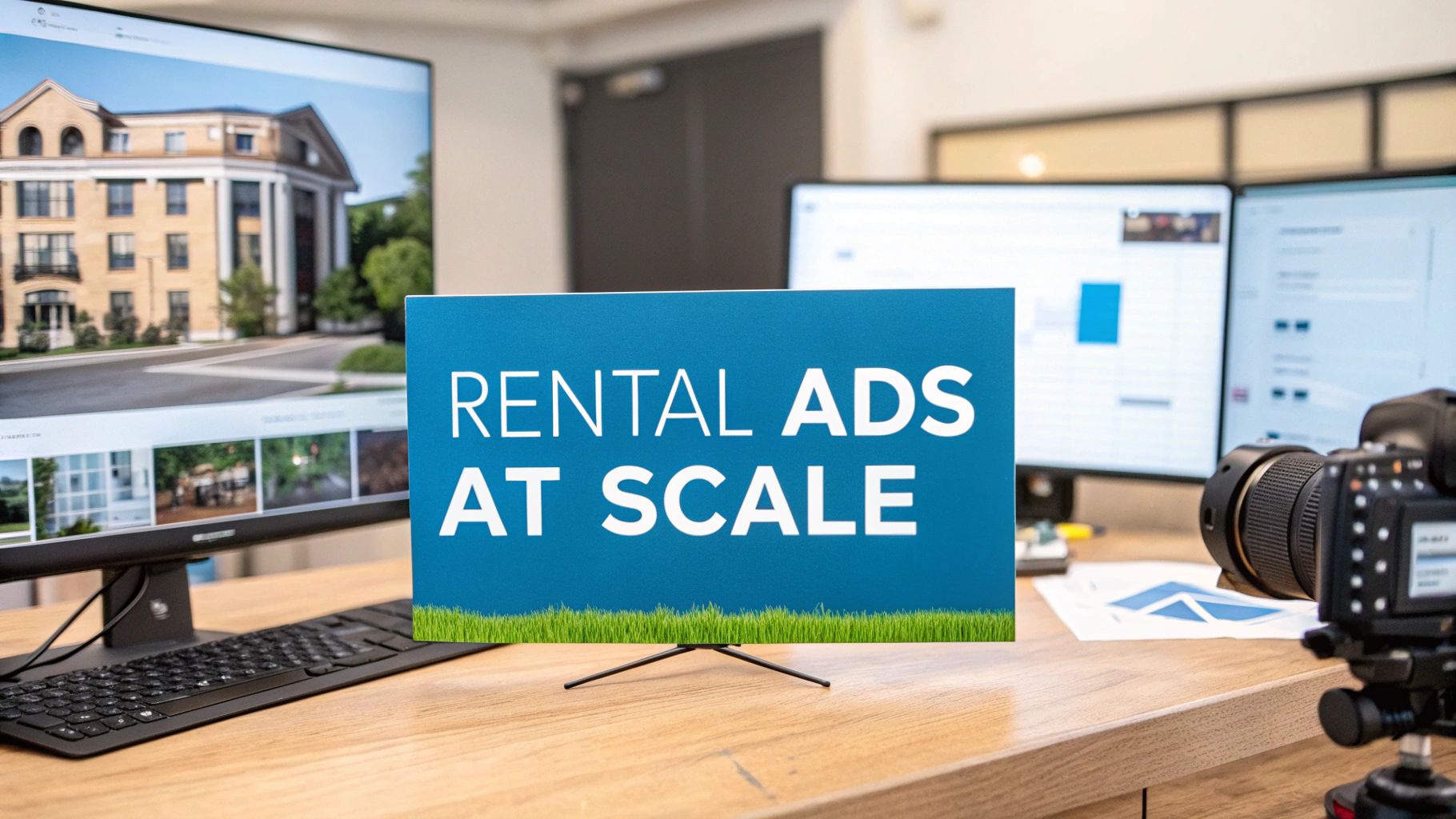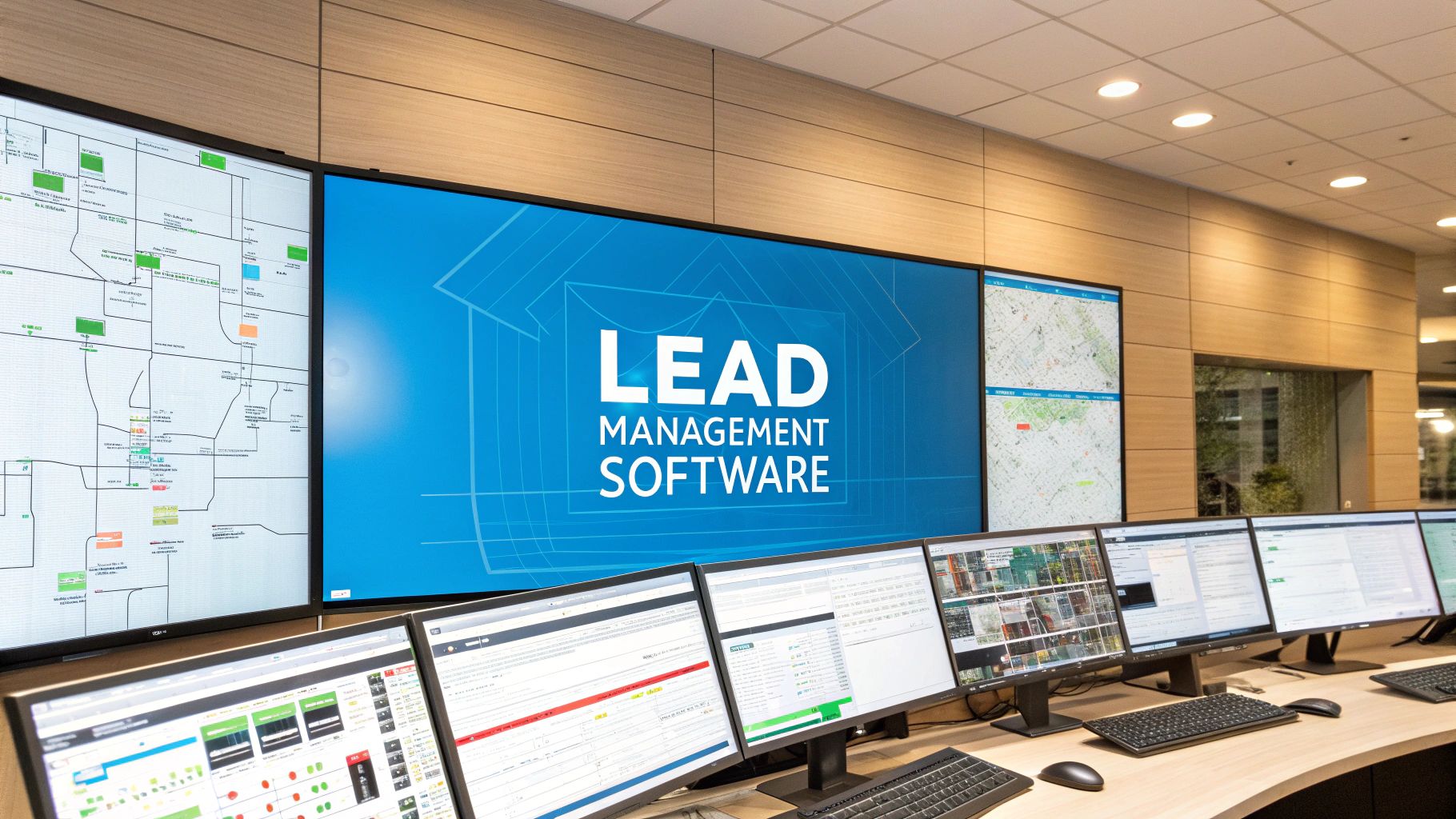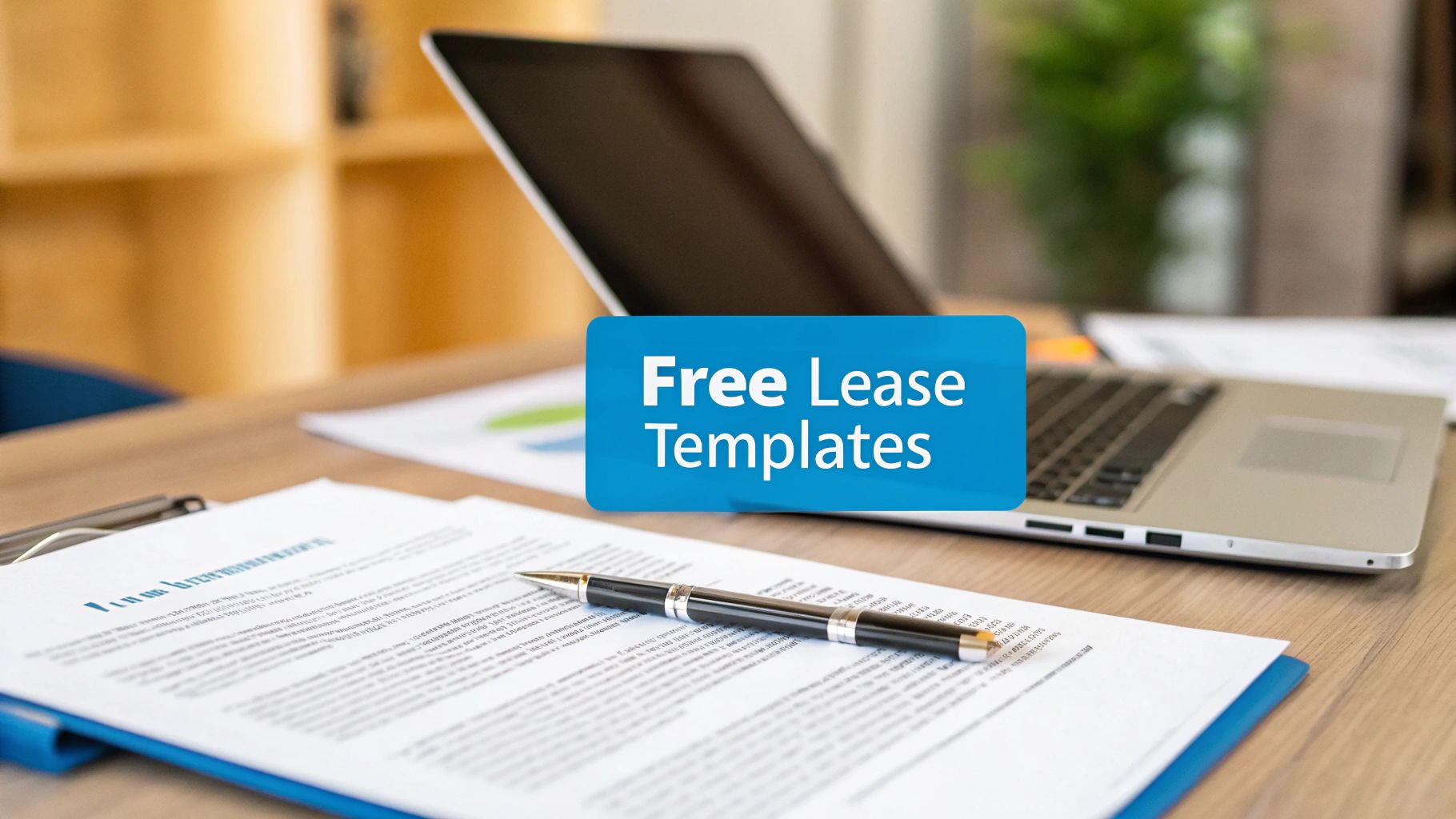When you're advertising a rental property at scale, you have to stop thinking about individual listings and start building a repeatable, data-driven system. For portfolios with hundreds or even thousands of units, the name of the game is creating a predictable machine that consistently crushes your Days on Market (DOM) and keeps revenue flowing. A 1% reduction in vacancy across a 5,000-unit portfolio can translate to hundreds of thousands of dollars in recaptured annual revenue.
This framework is your blueprint for achieving that level of operational efficiency and financial impact.
Building Your Scalable Rental Advertising Framework
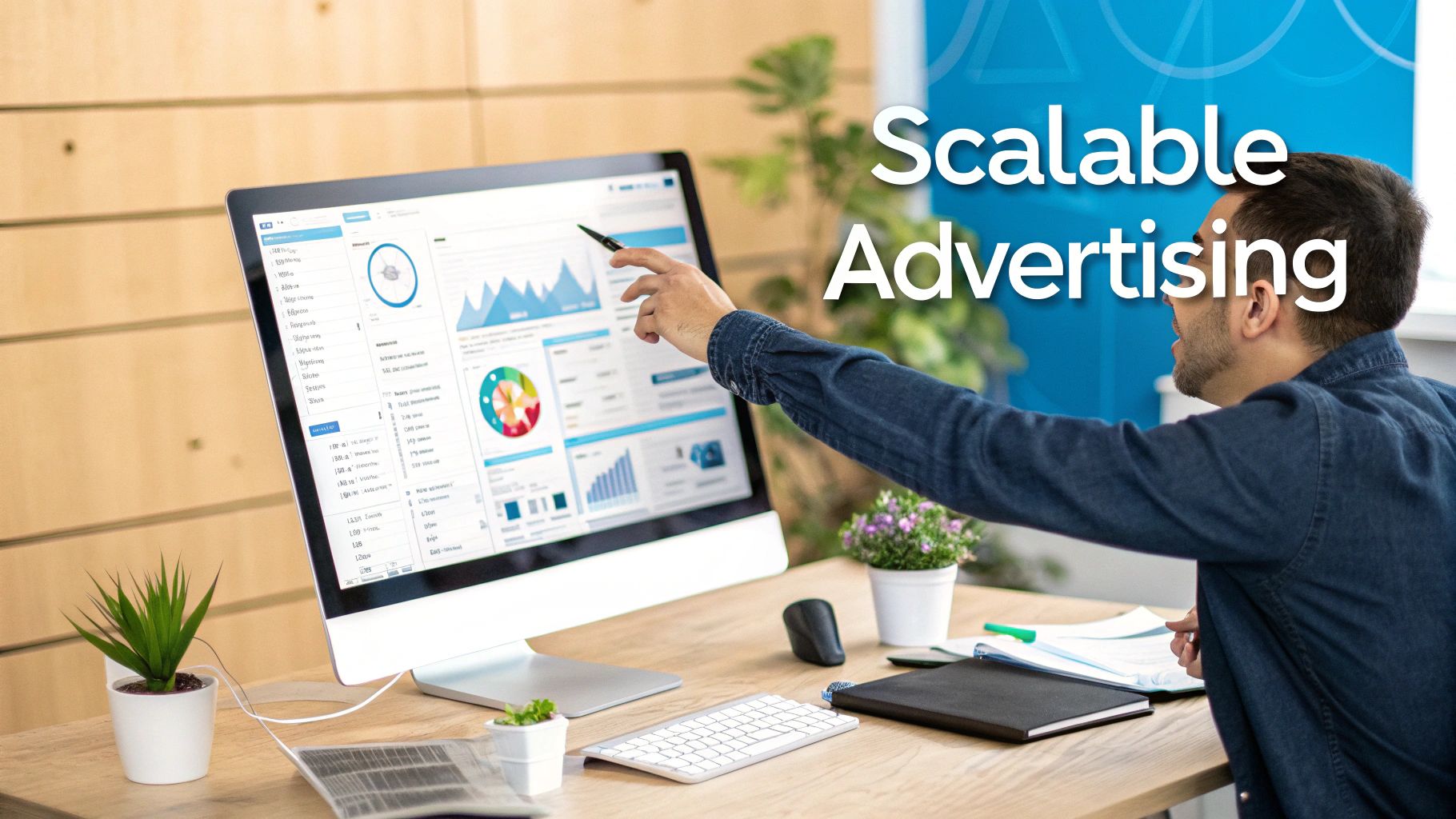
For large-scale property management companies, making the mental switch from a property-centric to a portfolio-centric mindset is everything. Instead of reinventing the wheel for every vacancy, you build an operational framework that standardizes excellence and delivers predictable, measurable results across multi-market portfolios.
Before you can effectively advertise any rental property, you need this robust system in place. It also helps to have a solid grasp of broader marketing concepts, like various Real Estate Investor Marketing Strategies. At its core, this system is built on three pillars designed for remote management and serious scalability.
The Three Pillars of Enterprise Advertising
A successful, high-volume leasing operation hinges on standardizing your key processes. It's the only way to guarantee quality and speed across a scattered portfolio without onsite staff. These pillars aren't just "best practices"—they are absolute necessities for slashing vacancy costs and optimizing your cost per door.
A Data-Driven Pricing Strategy: This goes way beyond just pulling comps. We're talking about leveraging your entire portfolio's data—analyzing lead velocity, conversion rates at different price points, and market trends—to make dynamic, informed adjustments. The goal is to set rents that perfectly balance occupancy rates and revenue per available unit.
Standardized Digital Presentation: Every single property, regardless of its location, needs a consistent, high-quality digital footprint. This means professional photography, 3D tours, and compelling ad copy templates ready to deploy in an instant. This ensures brand consistency and attracts qualified leads from day one, boosting lead-to-tour conversion rates.
Automated Lead Management & Tour Scheduling: Speed-to-lease is paramount. This pillar is all about using technology to automate lead responses, pre-screening, and tour scheduling. The goal is to engage prospects within minutes, not hours, which dramatically improves your lead-to-tour conversion rate and prevents lead leakage to competitors.
At an enterprise scale, every single day a unit sits empty represents a massive, cumulative revenue loss. A scalable advertising framework attacks this problem head-on by systematizing the actions that lead to faster lease-ups. It transforms leasing from a reactive chore into a proactive, revenue-generating engine that directly impacts your portfolio's financial performance.
This strategic approach has never been more critical. The competitive landscape is fierce, making a powerful digital presence completely non-negotiable for large portfolios.
The proof is in the numbers. Listings that feature high-quality visuals are seeing 60–80% faster lease-ups and are commanding up to 20% higher rent premiums. It’s clear that investing in a scalable, professional presentation model delivers a very real, very tangible ROI by directly reducing DOM.
Why Your Digital Curb Appeal Matters—And How to Scale It
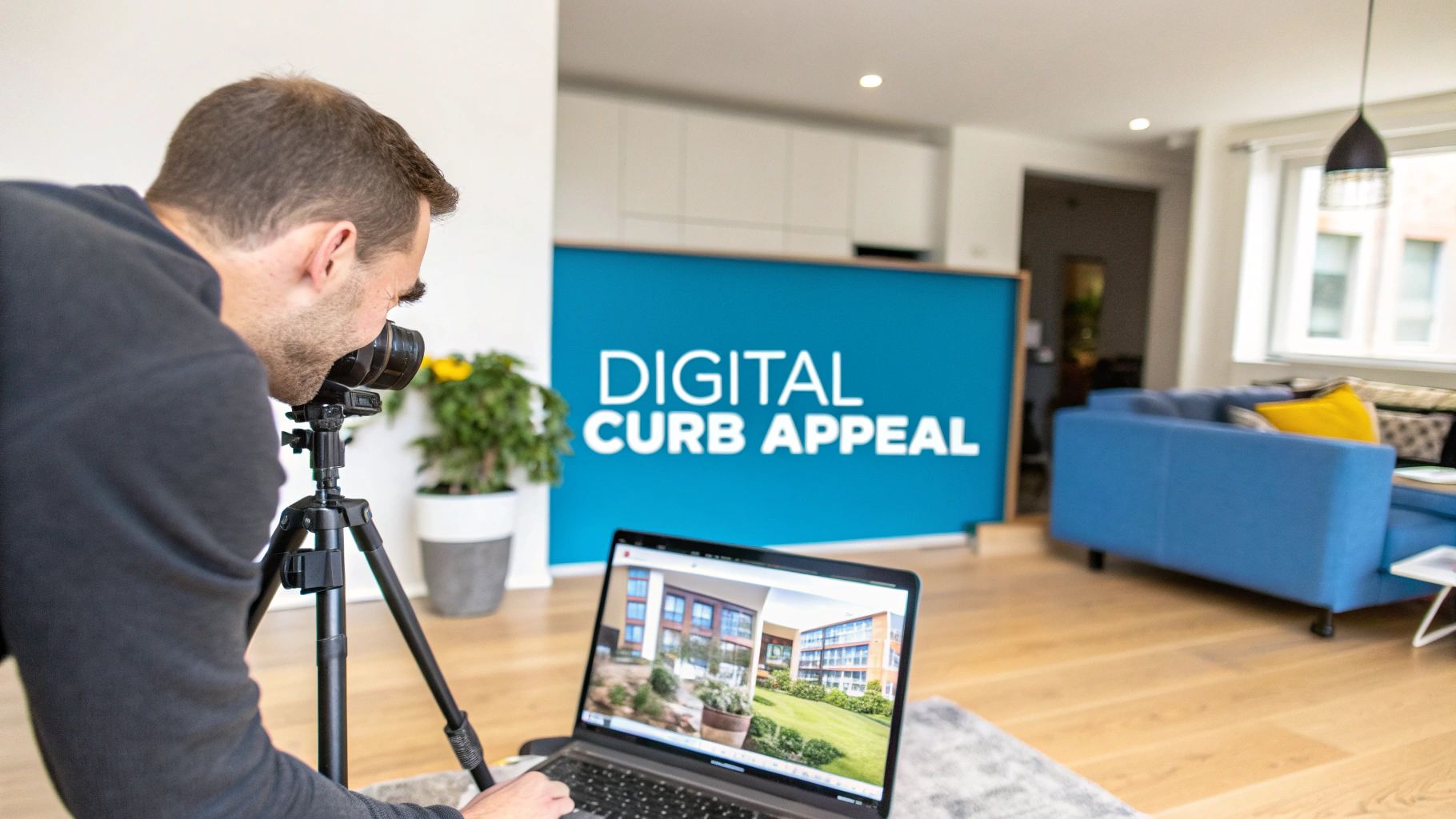
In today's rental market, your property's "digital curb appeal" is everything. It's the first impression that determines whether a qualified prospect clicks to learn more or schedules a tour. For a large, multi-market portfolio, this presentation must be professional, consistent, and scalable.
If it's not, you're bleeding leads and increasing your cost per acquisition. It's time to build a system for creating high-quality visual assets across hundreds or thousands of units. The key is to create a standardized "visual package"—professional photography, 3D tours, and virtual staging—that can be ordered and deployed remotely, ensuring brand quality and operational efficiency everywhere.
Building a Scalable Visual Asset System
Your first move is to contract with national or multi-regional vendors who can deliver consistent results at a predictable cost per door. When vetting partners, focus on turnaround times. A photographer who takes a week to deliver images is a liability that directly increases your Days on Market (DOM). Speed is a critical operational metric.
Next, create a crystal-clear shot list and style guide for each property type in your portfolio. This isn't just a suggestion; it's a blueprint for standardization. Specify everything:
- The ideal time of day for photos to maximize natural light.
- The exact angles required for the kitchen, living room, and bedrooms.
- Mandatory shots of amenities, closet space, and outdoor areas.
This level of detail eliminates guesswork. It means a one-bedroom apartment in Phoenix looks just as polished as a similar unit in Portland. Your remote teams can order a visual package with a single click and know exactly what they're getting, ensuring process standardization across the portfolio.
The impact here is immediate and significant. We've seen that professionally photographed homes not only rent 32% faster but also rack up 1,200% more social media shares, expanding your marketing reach organically.
Think about it: viewers spend 60% of their time looking at listing photos and only 20% on the description. Your visuals aren't just a nice-to-have; they're the primary driver of lead generation. You can dig into more of these key real estate marketing statistics on photoup.net.
For a portfolio manager, the goal is to make every listing a powerful, self-sufficient asset that attracts qualified tenants 24/7. A small, upfront investment in professional visuals pays for itself by directly reducing DOM and supporting higher rents, improving unit economics.
Quantifying the ROI of Visuals
Calculating the return on your visual assets is a straightforward exercise in vacancy cost analysis. Just compare the cost of a professional photo and 3D tour package against the revenue you lose from even one or two extra days of vacancy. When you multiply that across your entire portfolio, the math becomes incredibly compelling.
Let's run the numbers. If your average daily rent is $60, and a professional visual package shaves just five days off your DOM, you've already generated $300 in revenue that would have been lost. That easily covers the cost of the service and makes your cost-per-door much more efficient.
Visual Asset ROI Comparison for Large Portfolios
This table compares the costs, implementation challenges, and expected ROI of different visual assets when deployed at scale, helping portfolio managers prioritize their advertising spend.
Ultimately, a blended approach is often best. Starting with professional photography and 3D tours as your standard package provides the highest ROI and creates a powerful foundation for every listing in your portfolio.
Optimizing Listing Syndication and Ad Performance
Having a stunning digital presentation is wasted if it never reaches qualified prospects. For property managers juggling multi-market portfolios, effective advertising requires a robust system for both listing syndication and performance tracking. This isn't just about posting to a few sites; it's about building a smart, data-driven machine that maximizes exposure while optimizing your cost-per-lead.
The primary goal is to automate the entire syndication process. Your property management systems should push perfectly crafted listings to a curated list of top-performing channels—think Zillow, Trulia, and Apartments.com—with a single click. This is where API integrations with your property management software are non-negotiable. They eliminate hundreds of hours of manual data entry and ensure listing data is consistent everywhere, protecting your brand integrity.
Once that automated foundation is in place, your team is free to focus on what really moves the needle: analyzing performance data and fine-tuning your ad spend for maximum ROI.
Data-Driven Channel Selection
Not all listing sites are created equal. Your strategy must be flexible, adapting based on real performance data from different markets and property types.
Start by tracking these core metrics for every single advertising channel:
- Cost Per Qualified Lead: How much are you spending to get a prospect who meets your basic screening criteria?
- Lead-to-Tour Conversion Rate: Which sites consistently deliver leads who actually schedule and attend a tour? This is a critical KPI for operational efficiency.
- Cost Per Lease: What’s the total ad cost that went into securing a signed lease from each platform?
Analyzing this data allows you to allocate budget to the channels that deliver real results and cut the ones that are just wasting money. You might find that Zillow brings in the highest volume of raw leads, but Apartments.com gives you a much better cost per lease for your two-bedroom units in a specific submarket. An effective strategy for using Zillow listings is all about tapping into its massive reach while keeping a close eye on the quality and conversion rate of the leads it sends your way.
This level of detail is more important than ever. The U.S. rental market saw a massive expansion in 2024, with over 600,000 new multifamily units hitting the market—that's a 65% increase from 2022. With that much new inventory, your advertising has to be smarter and more targeted to cut through the noise. You can get more details on these rental market trends on amraandelma.com.
For enterprise portfolios, syndication isn't just about being present; it's about performance. The objective is to create a feedback loop where lead data from your PMS and showing platforms informs your ad budget in real-time, maximizing ROI across thousands of units.
A/B Testing for Continuous Improvement
Once your syndication is automated, you can systematically test your ad creative to improve performance. Set up a simple framework to A/B test elements like your headlines and primary photos.
For instance, try running two different headlines for the same property type for one week:
- Headline A (Feature-focused): "Spacious 2-Bed, 2-Bath with Stainless Steel Appliances & In-Unit W/D"
- Headline B (Benefit-focused): "Your Perfect Work-From-Home Oasis with Private Balcony & Natural Light"
Track the click-through rates and, more importantly, the lead-to-tour conversion rates each one generates. A small improvement in performance makes a massive difference when multiplied across a portfolio of thousands of units. It directly translates into a lower Days on Market (DOM) and a significant boost to your portfolio's revenue.
Automating Lead Response to Accelerate Leasing Cycles
In today's on-demand rental market, the window to capture a high-intent lead is incredibly small. For large portfolios managing thousands of units, a manual lead response system is a direct path to lost revenue and inflated DOM.
Every hour you wait to reply is an opportunity for a qualified prospect to book a tour with a competitor. Speed-to-lead isn’t just a metric; it's a core competitive advantage that directly impacts your bottom line.
The only scalable solution is to build an automated lead response and tour scheduling system that converts interest into action instantly. This system works 24/7 to engage prospects the moment they inquire, eliminating the friction that causes leads to go cold. It's about building an operational machine that ensures no lead ever falls through the cracks, standardizing the prospect experience across your entire portfolio.
The Essential Automation Tech Stack
An effective system uses technology to handle the repetitive, time-sensitive tasks that bottleneck your leasing agents. The goal is to free up your team to focus on high-value activities—like nurturing qualified leads and closing leases—not just chasing down prospects to schedule a showing.
A modern automation workflow typically includes:
- AI-Powered Chatbots and Responders: These tools provide instant, intelligent answers to common prospect questions about pet policies, availability, and application requirements, keeping renters engaged on your listings.
- Automated SMS and Email Follow-ups: The moment a lead comes in from Zillow or Apartments.com, an automated text message can be sent to their phone, inviting them to pre-qualify or book a tour on the spot.
- Self-Service Tour Scheduling: This is the most critical component. It empowers prospects to view available tour times and book a same-day showing directly from their phone, without any human intervention. This is essential for remote management operations.
This immediate, seamless experience is what today's renters expect. By removing manual delays, you can drastically improve your lead-to-tour conversion rate.
At scale, the difference between a five-minute and a five-hour response time is thousands of dollars in vacancy loss. Automation bridges this gap, ensuring every lead receives an immediate, professional touchpoint that moves them down the leasing funnel.
Designing an Effective Automation Workflow
Implementing automation is about creating a logical sequence of events that guides a prospect from initial inquiry to a scheduled tour with minimal friction.
For example, a powerful workflow could look like this: a prospect submits an inquiry, and within 60 seconds, they receive an SMS with a link to a pre-qualification questionnaire. Once they complete it, another automated message sends them a link to your self-service scheduling calendar. Simple, fast, and effective.
This hands-off process not only accelerates the leasing cycle but also ensures that the tours your agents—or on-demand showing agents—conduct are with highly qualified, high-intent individuals.
For property managers looking to implement these systems, it's worth exploring platforms that offer integrated AI marketing automation designed specifically for the rental industry. This technology ensures you capture and convert leads faster than your competition, which directly reduces your Days on Market (DOM) and maximizes your portfolio's revenue.
Measuring Advertising Performance and ROI at Scale
You can't optimize what you don't measure. When you're managing a large portfolio, relying on gut feelings or surface-level metrics like clicks is a recipe for wasted ad spend and longer vacancies. Adopting a data-first mindset is critical for scaling profitably.
This means zeroing in on the Key Performance Indicators (KPIs) that directly impact financial performance: Days on Market (DOM), lead-to-tour conversion rates, cost per lease, and the raw financial cost of vacancy. These numbers turn your advertising from a line-item expense into a measurable, high-impact investment. The goal is to build a Portfolio Advertising Dashboard that pulls these vitals directly from your Property Management System (PMS) and tracks them week over week.
Building Your Portfolio Advertising Dashboard
To get a true handle on performance, your dashboard needs to provide a clear, real-time picture of your entire leasing funnel. This isn't just about checking on individual properties; it's about spotting the macro-level trends happening across your whole portfolio.
Here are the non-negotiable metrics to include:
- Days on Market (DOM): This is your ultimate report card on leasing velocity. Track the average DOM across different property types, markets, and even by leasing agent to quickly identify performance gaps and opportunities.
- Lead-to-Tour Conversion Rate: This KPI reveals the quality of your leads and the effectiveness of your initial response system. A low conversion rate could indicate issues with pricing, ad copy, or, most commonly, lead response time.
- Cost Per Lease (CPL): This is the bottom line. Divide your total ad spend over a given period by the number of leases signed. This metric gets right to the point: how efficiently are your marketing dollars converting to revenue?
Speaking of response times, speed is absolutely critical. Every minute you wait to engage a new lead, your chances of converting them plummet.

As you can see, responding to a lead within the first five minutes gives you a massive competitive advantage. This data makes a powerful business case for implementing automated response systems to engage prospects instantly, 24/7.
Calculating the True ROI of Your Advertising
The real magic happens when you connect your marketing efforts to tangible financial outcomes. A simple but incredibly effective way to do this is by calculating the true cost of vacancy.
The real ROI of great advertising isn’t just about filling one unit; it's about the revenue you recapture by shaving off vacancy days across your entire portfolio. A one-day reduction in DOM, when multiplied by thousands of units, translates into a massive financial win.
Let's break down how quickly the cost of vacancy adds up for a portfolio of 1,000 units. Even a single day of vacancy across the board represents a significant revenue leak.
DOM Cost Analysis Per 1,000 Units
This table makes it crystal clear: every day counts. When your advertising strategy can reduce the average DOM by even two or three days, you're not just saving a little money—you're adding hundreds of thousands of dollars back to your bottom line.
By tracking these core metrics, you can stop guessing and start making confident, data-backed decisions. You'll know exactly which channels and strategies deliver measurable results, ensuring every dollar you spend on advertising a rental property is a direct contribution to your portfolio's growth and profitability.
Integrating Your Tech Stack for Maximum Efficiency
If your tools don't talk to each other, you're creating friction that kills your ability to scale. For any property manager overseeing thousands of units, a collection of disconnected, single-purpose apps isn't a strategy—it's an operational liability. Real efficiency is born from an integrated PropTech stack where your core systems communicate seamlessly.
This means your Property Management Software (PMS), CRM, and showing platforms must be connected via API, creating one uninterrupted flow of leasing data. When these systems are in sync, you eliminate the costly manual work and data entry that bloat your leasing cycle and add precious Days on Market (DOM).
What This Looks Like in the Real World
Picture a workflow where simply marking a unit as "vacant" in your PMS triggers a fully automated chain reaction:
- The listing is instantly syndicated to your top-performing ad channels, complete with pre-approved photos and descriptions.
- New leads automatically populate your CRM, each one tagged with its source so you can track channel performance.
- Tour feedback from a platform like Showdigs syncs directly back to the lead’s profile in the CRM, giving your leasing team immediate context for intelligent follow-up.
This is the kind of automation that ensures no lead falls through the cracks and no staff time is wasted on redundant data entry. It transforms your leasing operation from a series of clunky, disconnected tasks into a smooth, well-oiled machine designed to sign leases faster.
An integrated tech stack is the central nervous system of a modern, remote-first property management operation. It ensures data integrity, accelerates the speed-to-lease, and provides the operational backbone needed to scale from 1,000 to 10,000 units without a proportional increase in headcount.
When evaluating new tech partners, their integration capabilities should be a primary consideration. Look for platforms built with an open API and a solid track record of connecting with the major enterprise PMS systems your team already relies on.
To see how these connections work in practice, you can explore a range of property management software integrations built to unify your entire leasing process, from first click to signed lease.
Answering Your Top Questions
Even with a solid game plan for advertising your rental properties, a few questions always pop up, especially when you're managing a large, distributed portfolio. Let's tackle some of the most common ones we hear from operations directors and portfolio managers.
What’s the Single Most Important Metric to Track?
While it’s easy to get lost in metrics like cost-per-lead, Days on Market (DOM) is the ultimate KPI. Think of it as the final scorecard for your entire leasing process, from the moment an ad goes live to the day a lease is signed.
Every single day a unit sits empty, you're losing revenue. It's that simple. Shaving just a few days off your portfolio's average DOM can add tens or even hundreds of thousands of dollars straight back to your annual revenue. It is the metric that most directly reflects the financial health of your leasing operations.
How Do We Actually Measure ROI on Ad Spend?
To get a real, tangible ROI at scale, you must draw a direct line from your ad budget to signed leases and reduced vacancy. First, calculate your cost per lease. Divide your total monthly ad spend by the number of leases you signed that month.
Now for the powerful part. Let's say a $5,000 ad campaign helps you reduce your portfolio's average DOM by two days. If your portfolio's daily vacancy cost is $60,000, you just spent $5k to recapture $120,000 in revenue that would have otherwise been lost. That's the kind of ROI analysis that justifies strategic marketing investment.
Should We Bother Allowing Pets?
For any large-scale operation, the answer is almost always yes. Allowing pets instantly expands your pool of qualified applicants, which is one of the fastest ways to slash your DOM. The concerns about property damage are real, but they are absolutely manageable at scale with standardized policies.
The key is a standardized pet policy. By implementing pet fees, pet rent, and clear breed/weight restrictions, you open the door to a much larger market while protecting your assets. Most large portfolio managers find the extra income and faster lease-ups easily outweigh the potential operational costs.
Ready to make "Days on Market" a number you're proud of? Showdigs is the fastest path from lead to lease for distributed portfolios, combining smart software with a network of on-demand showing agents to get your properties leased faster. Book a demo today and see how we're helping enterprise-level property managers reduce DOM and optimize their cost per door.




